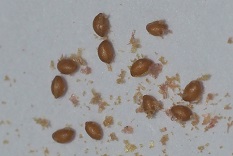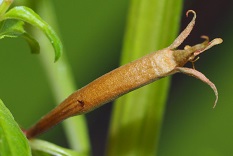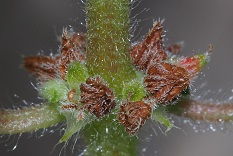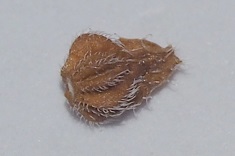| Home | Nature Weekly Index |
14 June 2020 | Seeds of Two Wild Herbs | Seedbox | Graceful Pouzolzsbush |
I usually grow wild herbaceous plants in my pots for the purpose of taking pictures or for observation if I want to know more about the plant. They do not take up a lot of space. Once I am done with them, I can remove them easily. But I do keep those that are relatively rare such as Spigelia anthelmia (Pinkroot), Solanum americanum (Black Nightshade) and Polygala paniculata (Root Beer Plant) by letting their seeds littered the soil. I will let some of them grow intermittently to keep the population going.

 As I shared on 3 May, I had isolated a
Water Primrose (Ludwigia hyssopifolia) seedling in a
small pot which had grown to bear flowers and fruits. This water-loving, erected herbaceous plant also goes by
the common name, Seedbox. Each bright yellow flower of Water Primrose appeared singly at the end of a swollen
stalk. After the petals of the flower dropped off, the swollen stalk which enclosed the ovary gradually turned
brown over time. I waited for weeks but the swollen stalk that contained the seed did not seem to release any
seed. When I hold onto one of the “seedbox” to cut it off the plant for examination, the surface of the seedbox
gave way. Some powdery materials that mixed with the numerous tiny seeds in there fell off. The seedbox became
fragile as it matures. At the impact of external forces, such as raindrops, the surface will rupture to release
the seeds. As the seeds are tiny and light, they can be carried away with the rain water and get dispersed.
Each oval-shaped seed is about 0.5 millimetre (mm) in length.
As I shared on 3 May, I had isolated a
Water Primrose (Ludwigia hyssopifolia) seedling in a
small pot which had grown to bear flowers and fruits. This water-loving, erected herbaceous plant also goes by
the common name, Seedbox. Each bright yellow flower of Water Primrose appeared singly at the end of a swollen
stalk. After the petals of the flower dropped off, the swollen stalk which enclosed the ovary gradually turned
brown over time. I waited for weeks but the swollen stalk that contained the seed did not seem to release any
seed. When I hold onto one of the “seedbox” to cut it off the plant for examination, the surface of the seedbox
gave way. Some powdery materials that mixed with the numerous tiny seeds in there fell off. The seedbox became
fragile as it matures. At the impact of external forces, such as raindrops, the surface will rupture to release
the seeds. As the seeds are tiny and light, they can be carried away with the rain water and get dispersed.
Each oval-shaped seed is about 0.5 millimetre (mm) in length.

 Separately, I brought back a wild herb,
Graceful Pouzolzsbush (Pouzolzia zeylanica) in December
last year. It was collected from a grass patch nearby my place. It was collected from a grass patch nearby my
place and in a rather poor condition due to frequent grass-cutting activity. Though the parent plant eventually
succumb, the seeds that came with it germinated. The small hairy fruits of Graceful Pouzolzsbush lined themselves
around the nodes of the plant. Each dry fruit that contained a single seed is about 2 mm long. This common wild
plant is from the from the Nettle family (Urticaceae). Another very
common plant from this same family that had been a long-term resident in my pot was the
Artillery Plant (Pilea microphylla).
Separately, I brought back a wild herb,
Graceful Pouzolzsbush (Pouzolzia zeylanica) in December
last year. It was collected from a grass patch nearby my place. It was collected from a grass patch nearby my
place and in a rather poor condition due to frequent grass-cutting activity. Though the parent plant eventually
succumb, the seeds that came with it germinated. The small hairy fruits of Graceful Pouzolzsbush lined themselves
around the nodes of the plant. Each dry fruit that contained a single seed is about 2 mm long. This common wild
plant is from the from the Nettle family (Urticaceae). Another very
common plant from this same family that had been a long-term resident in my pot was the
Artillery Plant (Pilea microphylla).
Both Seedbox and Graceful Pouzolzsbush have a number of medicinal uses [1-3].
Unknowingly, the soil that attached to the Graceful Pouzolzsbush contained the seeds of 2 other wild plants, Eleusine indica (Goose Grass) and Phyllanthus debilis (Niruri). I will keep the Niruri for a while but the Goose Grass was removed. Last weekend, I brought back another herb, Justicia procumbens (Water Willow).
References:
[1] Hossain MS, Rahman MS, Imon AHMR, Zaman S, Siddiky ASMBA, Mondal M, Sarwar A, Huq TB, Adhikary BC, Begum T, Tabassum A, Alam S, Marium Begum MM. Ethnopharmacological investigations of methanolic extract of Pouzolzia Zeylanica (L.) Benn. Clinical Phytoscience 2016;2:10. | Read article |
[2] Das B, Kundu J, Bachar SC, Uddin MA, Kundu JK. Antitumor and Antibacterial Activity of Ethylacetate Extract of Ludwigia Hyssopifolia Linn and Its Active Principle Piperine. Pak J Pharm Sci 2007;20(2):128-31. | Read article |
[3] Shaphiullah M, Bachar SC, Kundu JK, Begum F, Uddin MA, Roy SC, Khan MT. Antidiarrheal activity of the methanol extract of Ludwigia hyssopifolia Linn. Pak J Pharm Sci 2003;16(1):7-11. | Read article |